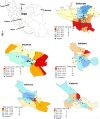Inequality in geographical distribution of hospitals and hospital beds in densely populated metropolitan cities of Iran
- PMID: 31470849
- PMCID: PMC6717334
- DOI: 10.1186/s12913-019-4443-0
Inequality in geographical distribution of hospitals and hospital beds in densely populated metropolitan cities of Iran
Abstract
Background: This study aims to assess geographical distribution of hospitals and extent of inequalities in hospital beds against socioeconomic status (SES) of residents of five metropolitan cities in Iran.
Methods: A cross-sectional analysis was conducted to measure geographical inequality in hospital and hospital bed distributions of 68 districts in five metropolitan cities during 2016 using geographic information system (GIS), and Gini and Concentration indices. Correlation analysis was performed to show the relationship between the SES and inequality in hospital beds densities.
Results: The study uncovered marked inequalities in hospitals and hospital beds distributions. The Gini indices for hospital beds were greater than 0.55. The aggregated concentration indices for public and private hospital beds were 0.33 and 0.49, respectively. The GIS revealed that 216 (70.6%) hospitals were located in two highest socioeconomic status classes in the cities. Only 29 (9.5%) hospitals were located in the lowest class. The public, private, and the cumulative hospitals beds distributions in Tehran and Esfahan showed significant (p < 0.05) positive correlation with SES of the residents.
Conclusions: The high inequalities in hospital and hospital beds distributions in our study imply an overlooked but growing concern for geographical access to healthcare in rapidly urbanizing metropolitan cities in Iran. Thus, regardless of ownership, decision-makers should emphasize the disadvantaged areas in metropolitan cities when need arises for the establishment of new healthcare facilities in order to ensure fairness in healthcare. The metropolitan cities and rapid urbanization settings in other countries could learn lessons to reduce or prevent similar issues which might have hampered access to healthcare.
Keywords: Geographical distribution; Hospital beds; Hospitals; Inequality; Main cities; Regionalization.
Conflict of interest statement
The authors declare that they have no competing interests.
Figures
Similar articles
-
'Seeking affluent neighbourhoods?' a time-trend analysis of geographical distribution of hospitals in the Megacity of Tehran.Health Policy Plan. 2017 Jun 1;32(5):669-675. doi: 10.1093/heapol/czw172. Health Policy Plan. 2017. PMID: 28453720
-
Assessment the trend of inequality in the distribution of intensive care beds in Iran: using GINI index.Glob J Health Sci. 2014 Jun 25;6(6):28-36. doi: 10.5539/gjhs.v6n6p28. Glob J Health Sci. 2014. PMID: 25363104 Free PMC article.
-
The changing landscape of hospital capacity in large cities and suburbs: implications for the safety net in metropolitan America.J Urban Health. 2007 May;84(3):400-14. doi: 10.1007/s11524-007-9163-9. J Urban Health. 2007. PMID: 17492512 Free PMC article.
-
Urban inequalities in the 21st century economy.Appl Geogr. 2020 Apr;117:102188. doi: 10.1016/j.apgeog.2020.102188. Epub 2020 Apr 2. Appl Geogr. 2020. PMID: 32287517 Free PMC article. Review.
-
Regional disparities in the distribution of Sudan's health resources.East Mediterr Health J. 2020 Sep 24;26(9):1105-1114. doi: 10.26719/emhj.20.056. East Mediterr Health J. 2020. PMID: 33047802 Review.
Cited by
-
Predicting the mortality due to Covid-19 by the next month for Italy, Iran and South Korea; a simulation study.Gastroenterol Hepatol Bed Bench. 2020 Spring;13(2):177-179. Gastroenterol Hepatol Bed Bench. 2020. PMID: 32308940 Free PMC article.
-
High prevalence of zero-dose children in underserved and special setting populations in Ethiopia using a generalize estimating equation and concentration index analysis.BMC Public Health. 2024 Feb 23;24(1):592. doi: 10.1186/s12889-024-18077-w. BMC Public Health. 2024. PMID: 38395877 Free PMC article.
-
Estimation of economic burden of high salt intake in cardiovascular disease attributed to hypertension in Iran.Cost Eff Resour Alloc. 2025 May 20;23(1):21. doi: 10.1186/s12962-025-00631-x. Cost Eff Resour Alloc. 2025. PMID: 40394617 Free PMC article.
-
Non-COVID-19 hospitalization and mortality during the COVID-19 pandemic in Iran: a longitudinal assessment of 41 million people in 2019-2022.BMC Public Health. 2024 Feb 5;24(1):380. doi: 10.1186/s12889-024-17819-0. BMC Public Health. 2024. PMID: 38317148 Free PMC article.
-
Reduced economic disparity in biologics use for psoriasis after introducing the reducing copayment program.Sci Rep. 2024 Feb 20;14(1):4139. doi: 10.1038/s41598-024-54447-5. Sci Rep. 2024. PMID: 38374130 Free PMC article.
References
-
- Morris S, Sutton M, Gravelle H. Inequity and inequality in the use of health care in England: an empirical investigation. Soc Sci Med. 2005;60(6):1251–1266. - PubMed
-
- Onega T, Duell EJ, Shi X, Wang D, Demidenko E, Goodman D. Geographic access to cancer care in the US. Cancer. 2008;112(4):909–918. - PubMed
-
- Nobles M, Serban N, Swann J. Spatial accessibility of pediatric primary healthcare: measurement and inference. Ann Appl Stat. 2014;8(4):1922–1946.
-
- Ye H, Kim H. Measuring spatial health disparity using a network-based accessibility index method in a GIS environment: a case study of Hillsborough County, Florida. Int J Geospatial Environ Res. 2014;1(1):2.
Publication types
MeSH terms
LinkOut - more resources
Full Text Sources
Medical



